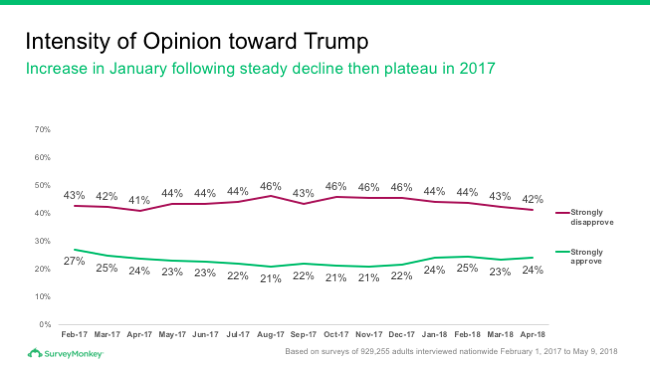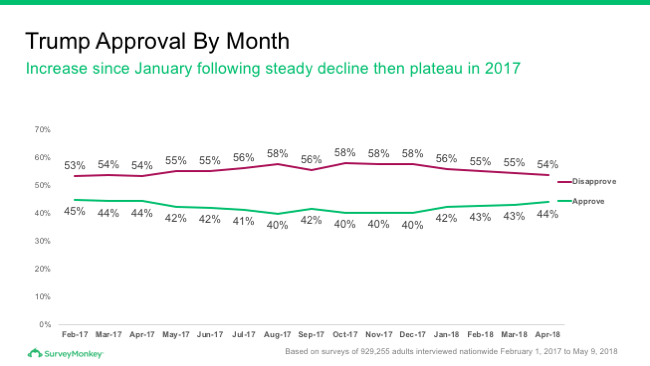Midterm elections historically result in the opposition party gaining ground as voters grow disaffected with the President. No one knows whether that will hold true this year. This is partly because of the unprecedented (in modern times) degree of polarization in the electorate, and partly because of Trump himself.
It’s still worth remembering Trump’s fundamental continuity with Republican politics, if not with its leadership. Trump’s raw, resentment-driven brand of nativist politics beautifully massaged the existing Republican base that developed out of the Southern Strategy, talk radio, and the Tea Party. But his appeal is evidently so much more visceral than most any other recent politician that his approval (and disapproval) ratings have been far more consistent than George W. Bush’s were.
Trump hovers around 40 percent, plus or minus 5 points. The media makes hay out of how his approval rating among Republicans hovers around 90 percent, but that’s in large part because being a Republican and loving Trump are now by and large the same thing. Republican party ID stands around 25 percent next to the Democrats’ 30 percent. Likewise, of his 40 percent support, 25 percent consistently strongly approve of Trump, while 15 percent moderately approve of him for things like appointing Gorsuch and not being Hillary Clinton.
So that 25 percent or so of the population that would follow Trump off a bridge is by and large the reality of that 90 percent figure. This is close to the fabled 27 percent crazification factor, and to the 25 percent who are certain that Jesus will return to earth by 2050. In other words, there may be things that will turn Trump’s core against him, but it’s very difficult to model their psychologies to predict what it will be. And Trump’s grip on them is very tight.
Based on Mark Blumenthal’s analysis, the United States more or less consistently has:

- A: 25% who love Trump unconditionally
- B: 15% who hate Democrats enough to support Trump
- C: 5% who have no opinion
- D: 15% who are lukewarm-to-disapproving on Trump
- E: 40% who despise Trump
It seems Trump has won over a few of those lukewarm 15% in recent months, but overall the numbers have been fairly stable. Of these categories, the news focuses most on A and E, who aside from making up 65% of the country also represent the deeply increased polarization and fragmentation in American politics. There are significantly more despisers than lovers, which frustrates and terrifies the despisers to no end.
The problem for the despisers is the B group, who back Trump less because he’s Trump than because he’s a Republican and not a Democrat. They have completely come to terms with Trump’s behavior and misdeeds and have decided he is worth it. Something may cause them to become disaffected with him, such as a major economic collapse, but by and large they are bought in. Nonetheless, they will break with Trump long before the A group does.
The D group is more mysterious. It’s hard for me personally to frame their mindset, since ambivalence is about the last thing Trump seems capable of provoking. Based on the numbers, D is comprised of people who dislike Trump’s personality and some of his policies but still think he might be helping the economy and national security. Maybe they liked the North Korea summit or the tariffs.
D may well be the decisive segment for the midterm elections, but I’ve seen no convincing analysis that frames them as a unified group. Most likely, they aren’t a unified group, but a collection of leaners in one direction or another, and there is no reliable strategy for convincing them. When a poll shows an uptick in Hispanic support for Trump, that’s probably coming out of the D group, but the rationale there is likely miles away from that of conservative Democrats in West Virginia who think Trump has conned them but cannot bear the thought of Nancy Pelosi being Speaker. Likewise for the other microgroups within D.
For example, I predict Eddie Devine will still vote Republican in November, even though he falls into the D group.
Lexington Herald-Leader: Devine said he believed Trump’s America-first promises. But cutting off a good supply of seasonal foreign labor when Americans won’t take those jobs is only hurting American business owners and the U.S. workers they employ, he said.
These workers aren’t immigrants, and there is no path to U.S. citizenship. When their seasonal work is done, they return home. That’s why Devine thinks the Trump administration’s stifling of guest-worker programs has more to do with racism than economics. “I think there’s a war on brown people,” he said.
But what makes him most angry is that Trump’s properties in Florida and New York have used 144 H-2B workers since 2016. “I want to know why it’s OK for him to get his workers, but supporters like me don’t get theirs,” Devine said.
I believe this is one of the most profound stories of 2018, but because it does not fit into any established narrative or trend, and because national reporters hardly ever go to Kentucky, it remains a local story and the Post and Times do not integrate it into their coverage. Instead we get articles about the right-wing nutcase on Youtube who thinks Solo promoted fluoridated water and which Netflix shows hate Trump the most.
The D group remains amorphous. And in the absence of a way to portray and frame the D group as a unity, both the political system and the media have focused near-exclusively on the extreme groups A and E. The turnout of those two groups is crucial to election results, though I’m not sure if it will be sufficient to counteract the caprice of D. There’s not much debate among the Republicans: they double down, following Trump, because that 25 percent of the nation that constitutes the A group is the dominant component of the Republican party now, if not the nation.
For Dems, there is a lot of typical debate about balancing between D and E. I think it is fruitless to worry about alienating or attracting D on the large scale. D is too amorphous. So it does make sense for the Dems to rile up the base, even if that may not be enough to tip them over the edge in crucial races.
Trump has boosted the enthusiasm of A and perhaps B, but the enthusiasm of E remains a real question, especially for swing districts and Senate seats like Indiana, North Dakota, Missouri, and West Virginia—where Dems are in danger of losing.
So it’s E—the despisers, of whom I count myself a member, and the group that I imagine largely constitutes my readership—that I’ll focus on in my next post.
- Trump Diary: Election Eve
- Trump Diary: Trump Alone
- Trump Diary: Cortisol Politics
- Trump Diary: Midterm Election Breakdown
- Trump Diary 13: Kill the Poor
- Trump Diary 12: Postponement of Reality
- Trump Diary 11: May Day
- Trump Diary 10: Everybody Hates Trump
- Trump Diary 9: Black Blocs and U-locks
- Trump Diary 8: Pseudonormalization Prevails

5 July 2018 at 13:09
I noticed in a previous diary you wrote: “Democrats are playing ostrich with their descent into being a regional party with an unenthusiastic and fractured base.” So, I take it you’re skeptical of the Dem conviction that demographics will make the GOP a minority party in the near future?
5 July 2018 at 14:08
“Near-future” seems very unlikely. Judis and Teixeira made the demographic argument back in 2002, and it hasn’t happened yet. (And Judis has abandoned it.) If Trump is holding on to 30% Latino support, as he seems to be, I don’t see a seismic shift in the next decade.
I think the best indicator here is less national races than state ones, since they determine the “bench” and diversity of the party constituency and appeal to a great extent.
Republicans currently hold 33 governorships. Federalism itself provides a hard backstop against demographic changes making too big of a difference in the short-term, but the presence of Republican governors in Massachusetts, Maryland, Illinois, New Meixco, *VERMONT*, and Maine (and that’s leaving aside supposed Dem bulwarks like Michigan and Wisconsin) indicates that Dems have a lock on far fewer areas than the Republicans do.
This fall, Vermont and Mass are considered safe holds for Republicans, even in spite of Trump. To add to that, Dem governors in Connecticut, Colorado, and Minnesota are in very close races. The Dems might do a bit of catch-up, and it will be auspicious if they do, but they will still be behind.
If there is a change to this dynamic, I could only see it happening due to an internal fracture within the Republican party. And to be fair, such fractures already exist. But the demographic conviction concerns events too far out in the future to be of any predictive value.
17 July 2018 at 20:10
David,
Do you think that what are pejoratively called SJWs have impact to motivate group B, who hate Trump but hate Democrats more?